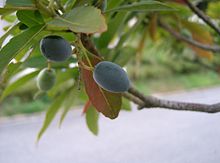Elaeocarpus sylvestris var. ellipticus
| Elaeocarpus sylvestris | |
|---|---|
 |
|
| Elaeocarpus sylvestris, branch with fruits | |
| Scientific classification | |
| Kingdom: | Plantae |
| (unranked): | Angiosperms |
| (unranked): | Eudicots |
| (unranked): | Rosids |
| Order: | Oxalidales |
| Family: | Elaeocarpaceae |
| Genus: | Elaeocarpus |
| Species: | E. sylvestris |
| Binomial name | |
|
Elaeocarpus sylvestris (Lour.) Poir. 1811 |
|
| Subspecies | |
|
|
| Synonyms | |
|
|
Elaeocarpus sylvestris, the woodland elaeocarpus, is a tree species in the genus Elaeocarpus.
The woodland elaeocarpus is found in China (Fujian, Guangdong, Guangxi, Guizhou, Hainan, Hunan, Jiangxi, Sichuan, Yunnan, Zhejiang), Japan, Korea, Taiwan and Vietnam (Indochina).
The tree is up to 15 m and is found in evergreen forests at altitudes comprised between 300 and 2000 m. The evergreen shiny leaves are oblanceolate. The greeny-white flowers are grouped in racemes and are followed by black olive-like fruit in autumn.
The fruits of the woodland elaeocarpus are edible. The oil from the seeds may be processed into soap or lubricants. The bark may be used as a source for dye. The wood does not resist water, so it is not considered good timber, but it is used for growing shiitake mushrooms.
It is also planted along streets and in parks.
The larvae of the moth Leucoblepsis excisa feed on the leaves of E. sylvestris. In urban forests of Kamakura, Kanagawa, Japan, the Formosan squirrel (Callosciurus erythraeus taiwanensis) is a pest to the tree because of its gnawing habit.
Woodland elaeocarpus in susceptible to Elaeocarpus yellows, a disease discovered in 1999 and a type of Phytoplasma disease, which causes a chlorosis (Japanese: 萎黄病 io-byo) of the plant.Oxytetracycline has been used to fight the pathogen.
This species contains the gallotannin 1,2,3,4,6-penta-O-galloyl-beta-D-glucose, a compound that may be used in radioprotection. It also contains elaeocarpusin, a molecule with a unique acid ester group probably derived by a condensation of a hexahydroxydiphenoyl group and dehydroascorbic acid attached to the 2,4-positions of 1-O-galloyl- 3,6-(R)-hexahydroxydiphenoyl-D-glucopyranose (corilagin).
The horutonoki (Elaeocarpus sylvestris var. ellipticus) is the tree symbol of Japanese city Urasoe, Okinawa. Wild Dampalsu trees (Elaeocarpus sylvestris var. ellipticus) in Cheonjiyeon Waterfall are South Korean Natural Monument no. 163.
...
Wikipedia
